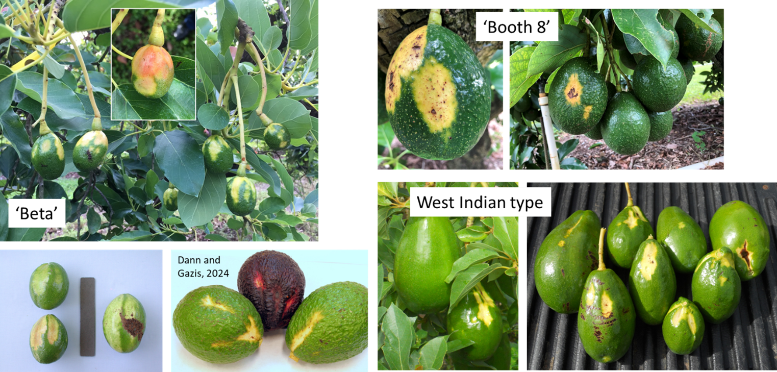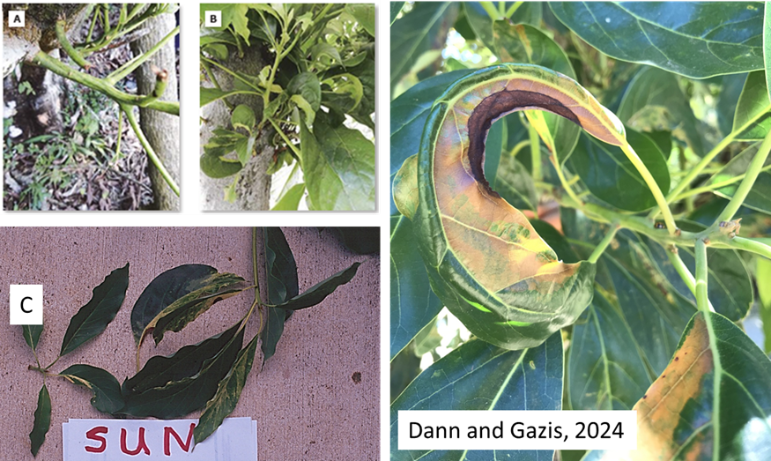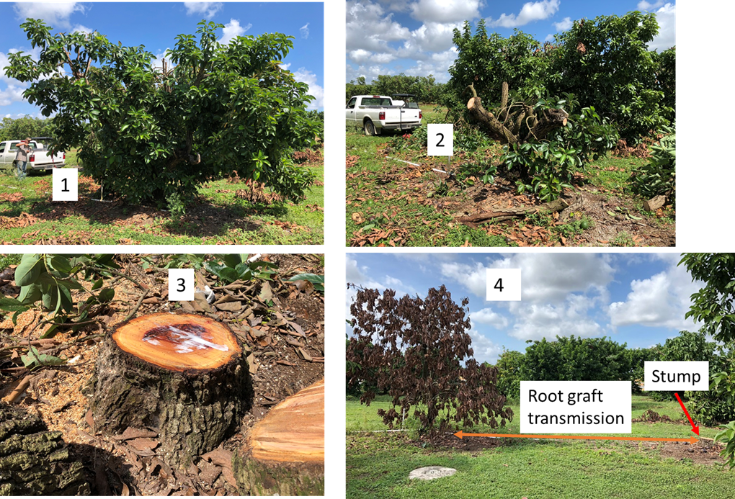Introduction
Avocado sunblotch viroid (ASBVd) occurs in avocado production areas throughout the world and was first reported in Florida in 1941 (Carabez et al., 2019). Three ASBVd surveys of an avocado germplasm collection in Florida over a 14-year period found the number of ASBVd-positive trees increased from ~19% to 24% during this time (Running and Schnell, 1996; Olano et al., 2002; Tondo et al. 2010). Of great concern was the fact that of the newly detected ASBVd positive trees in these surveys ~48% were adjacent to previously infected trees. Movement of the ASBVd pathogen was attributed to root grafting among adjacent trees, use of contaminated propagation material (i.e., seeds and budwood) and pollen transfer.
Recently, the number of avocado sunblotch viroid (ASBVd) infected trees in the Miami-Dade County production area appears to have increased (L. Dessaint, Brooks Tropicals, personal communication). The lack of widespread detection of ASBVd in the Miami-Dade County production area may be partly due to the severe symptoms and rapid tree loss caused by laurel wilt overshadowing most other disease concerns. Another reason for the absence of ASBVd detection may be the lack of familiarity with the disease among newer growers and managers. Additionally, ASBVd symptoms may only appear on certain parts of the tree, may not be present at all times, and may not manifest symptoms every year (Dann and Gazis, 2024; Menge and Ploetz, 2003).
ASBVd is of major concern in all avocado producing countries due to the negative effect this viroid has on fruit production and fruit quality. The Florida avocado industry does not have a state-industry avocado budwood and seed certification program to prevent the propagation of avocado sunblotch viroid (ASBVd) trees. Historically, Florida’s avocado producers were familiar with the symptoms of the viroid and took appropriate action to control its spread. However, without due vigilance on the part of the industry the number of ASBVd trees could increase again, further affecting the industry's fruit production and quality. This is especially important because of the thousands of new trees being produced for replanting and for new planting efforts.
What is it?
Avocado sunblotch is a systemic disease caused by the avocado sunblotch viroid (ASBVd) which is a single-stranded circular RNA molecule that hijacks the host cell DNA-dependent RNA polymerase system to replicate (i.e., make more of itself). Viroids are the smallest known infectious agents and were discovered in the 1970s (Menge and Ploetz, 2003). ASBVd probably co-evolved with avocado trees eons ago in Mexico, Central America, and northern South America.
Why is it important?
ASBVd can drastically reduce crop yields (14-80% reduction), fruit quality, and cause tree decline (Carabez et al., 2019; Dann and Gazis, 2024; Zwane, 2022). The ASBVd viroid interacts with the avocado host cells and causes changes in normal gene expression leading to detrimental effects on fruit set, vegetative growth (i.e., leaf distortion), fruit quality (e.g., mishappen fruit, peel discoloration), and fruit production (reduced). The ASBVd-pathogen is not evenly distributed throughout the tree, i.e., some branches and fruit may show symptoms, others do not. However, even non-symptomatic but infected trees can transmit viroid through seed (Carabez et al., 2019; Menge and Ploetz, 2003). Left uncontrolled, ASBVd infected trees in the grove will act as a reservoir to infect other trees, causing the loss of fruit production and fruit quality.
ASBVd is primarily spread through contaminated budwood used for grafting, budding, and top-working, natural root grafts among adjacent trees and via pruning and injection equipment (Dann and Gazis, 2024). ASBVd may also be spread by honeybees carrying ASBVd contaminated pollen from infected trees (Jooste et al., 2022; Zwane, 2022). While the transmission of ASBVd via pollen is relatively low (1.8% to 3.1%), it has been shown that bee transmission of ASBVd-contaminated pollen is possible at least 328 feet away from the ASBVd-infested tree. (Roberts et al., 2023). If an infected seed is used as a rootstock to propagate a new tree the whole new tree (seedling or grafted) will be infected with ASBVd. This also reinforces the need to detect and remove ASBVd symptom and symptomless avocado trees because their seeds may be used in propagation (Jooste, 2024).
What are the symptoms of ASBVd infection?
Unfortunately, some trees may not consistently show symptoms. However, symptoms can appear after a stress event, such as drastic pruning, stumping, or a significant environmental event like a hurricane that damages the tree.
- Fruit: The peel of the fruit may have yellow, white, or pink streaks or blotches that are indented and run lengthwise from the stem-end. Severely affected fruit will develop necrotic brown-black crevices (Fig. 1).
- Vegetative leaves and stems: Leaf symptoms are uncommon but may show chlorotic (yellow, white, or pink) areas and the leaves may be distorted (Menge and Ploetz, 2003; Dann and Gazis, 2024) (Fig. 2). Normally green stems may show longitudinal streaks of yellow, white, or pink that eventually become sunken and necrotic. Tree bark may have a rectangular cracked appearance. Trees may be stunted with sparse canopy and a spreading tree architecture unlike non-infected trees of the same cultivar.
- A drastic reduction in crop yield of individual trees may indicate ASBVd infection (maybe a symptomless infected tree) (Palmateer et al., 2006).

Figure 1. Fruit symptoms of sun blotch viroid (all sample from Homestead, FL). Note symptoms may appear on young and mature fruit. The peel has sections of depressed peel with yellow, pink, and/or brown coloration.

Figure 2. A. Streaks on young stems of a ‘Fuerte’ tree (Joost and Zwane, 2021). B. Yellow streaks and leaf distortion symptoms on the emerging growth (Joost and Zwane, 2021). C. Yellow streaking and leaf distortion on non-identified avocado tree in Homestead, FL.
Nurseries and propagation operations
Propagation of new avocado trees with ASBVd infected budwood and/or seeds is the main method by which ASBVd spreads. Nurseries should have the trees harvested for seedling rootstocks and budwood tested annually regardless of whether they show ASBVd symptoms or not. This will prevent the use of ASBVd infested seedlings and budwood for propagation purposes (Dann and Gazis, 2024; Menge and Ploetz, 2003). Test samples should consist of at least 10 randomly selected mature leaves and be submitted to the UF/IFAS Plant Diagnostic Clinic at the UF/IFAS Tropical Research and Education Center in Homestead, FL . If symptomatic leaves, stems, or fruit are present, they should be included in the submission. Asymptomatic but infected tree samples may lead to false negatives due to limitations in detection. All pruning and grafting tools should be sanitized (e.g., 1.5% sodium hypochlorite solution) between grafts or buds to prevent the transmission of ASBVd.
Avocado producers
Avocado grove managers and staff should be informed of the symptoms of ASBVd and always be on the lookout for trees (or parts of trees) with fruit, leaf, stem, or bark symptoms. In south Florida, the detection of fruit exhibiting ASBVd symptoms has been the most commonly observed symptom. (J. Crane, personal communication). Symptomatic trees and adjacent non-symptomatic trees should be tagged and tested for ASBVd and if positive must be removed and destroyed. Destruction methods include uprooting, shredding, dismembering, and chipping.
Since ASBVd can move through root grafts to adjacent trees the optimum way to detect and destroy non-symptomatic but ASBVd infected adjacent trees is to stump the symptomatic tree to the ground and immediately paint the fresh stump with glyphosate (or another systemic herbicide) (Fig. 3). Any adjacent trees showing herbicide damage symptoms (usually several days later) are root-grafted to the symptomatic tree and their destruction should be completed.
All pruning equipment, clippers and injection equipment should be thoroughly cleaned and disinfested when working between trees (Dann and Gazis, 2024). We do not know if ASBVd can be moved by mechanized topping/hedging equipment and chain saws – this needs to be investigated but is has been documented ASBVd is transferred by grafting tools and hand pruning equipment (Jooste et al., 2022).
Remember, if you do not destroy the ASBVd infested trees, the pathogen will spread by root grafts, contaminated seed (if used for rootstock), budwood if used for propagation, pollen and through pruning equipment.

Figure 3. 1. Booth 8 tree positive for sun blotch viroid; 2. Tree cut down to a stump; 3. After cutting the stump was immediately painted with systemic (glyphosate) herbicide to detect any adjacent tree infected with ASBVd; and 4. Adjacent tree with late-stage symptoms of herbicide damage (dead leaves). That tree was then removed and destroyed.
Avocado packinghouses
Avocado packinghouse managers and staff should be vigilant for symptomatic fruit and report any findings to management. This way, management can inform the owner of the affected fruit that there are one or more ASBVd-affected trees in their grove.
- Become familiar with the symptoms of avocado sunblotch viroid and train your staff to identify and tag suspicious trees so they and adjacent trees can be tested at the UF/IFAS Tropical Research and Education Center, Plant Diagnostic Clinic [https://trec.ifas.ufl.edu/plantdiagnosticclinic/].
- When trees test positive for ASBVd they should be destroyed. One easy way to detect if ASBVd has moved to adjacent trees is to stump the ASBVd-positive tree and immediately paint the fresh stump with a systemic herbicide – then wait to see if herbicide damage symptoms develop on any adjacent tree. If they do, destroy those trees as well.
Carabez, J.R.S., D.T. Ortiz, M.R.V. Perez, and H.B. Pena. 2019. The avocado sunblotch viroid: an invisible foe of avocado. Viruses 11, 491; doi:10.3390/v11060491.
Dann, E.K. and R. Gazis. 2024. Foliar, fruit and soilborne diseases. In: The Avocado: Botany, Production and Uses (third edition). CABI International, N.Y. pages 481-547.
Jooste, E. 2024. The role of honeybees in the spread of avocado sunblotch viroid (ASBVd). So. African Avocado Growers’ Association Yearbook 47:54-55.
Jooste, A.E.C., L.C. Motaung, A.B. Msweli, and Z.R. Zwane. 2022. Understanding field transmission of avocado sunblotch viroid (ASBVd). So. African Avocado Growers’ Association Yearbook 45:40-42.
Jooste, A.E.C. and Z.R. Zwane. 2021. Avocado sunblotch viroid (ASBVd) symptom identification and detection in avocado orchards. So. African Growers’ Association Yearbook 44:66-71.
Menge, J.A. and R.C. Ploetz. 2003. Diseases of avocado. In: Diseases of Tropical Fruit Crops. CABI International, N.Y. pages35-71.
Olano, C.T., R.J. Schnell, and D.N. Kuhn. 2002. Current status of ASBVd infection among avocado accessions in the national germplasm collection. Proc. Fla. State Hort. Society. 115:280-2082.
Roberts, J.M.K., A.E.C. Jooste, L-S. Pretorius, and A.D.W. Geering. 2023. Surveillance for avocado sunblotch viroid utilizing the European honeybee (Apis mellifera). Phytopathology 113:59-566.
Running, C.M. and R.J Schnell. 1996. Detection of avocado sunblotch viroid and estimation of the infection among accessions in the national germplasm collection for avocado. Proc. Fla. State Hort. Society 109:235-237.
Tondo, C.L., R.J. Schnell, and D.N. Kuhn. 2010. Results of the 2009 ASBVd survey of avocado accessions of the national germplasm collection in Florida. Proc. Fla. State Hort. Society. 123:5-7.
Zwane, Z.R. 2022. A study on avocado sunblotch viroid (ASBVd) with a focus on symptomless carrier trees. Dissertation, University of KwaZulu-Natal, King Edward Avenue, Scottsville, Pietermaritzburg, Private Bag X01, 3209. 123 pages.
Dr. Jonathan Crane
Tropical Research & Education Center
18905 SW 280 Street
Homestead, FL 33031
Phone: (305) 246-7000
Fax: (305) 246-7003
E-mail: jhcr@ufl.edu




